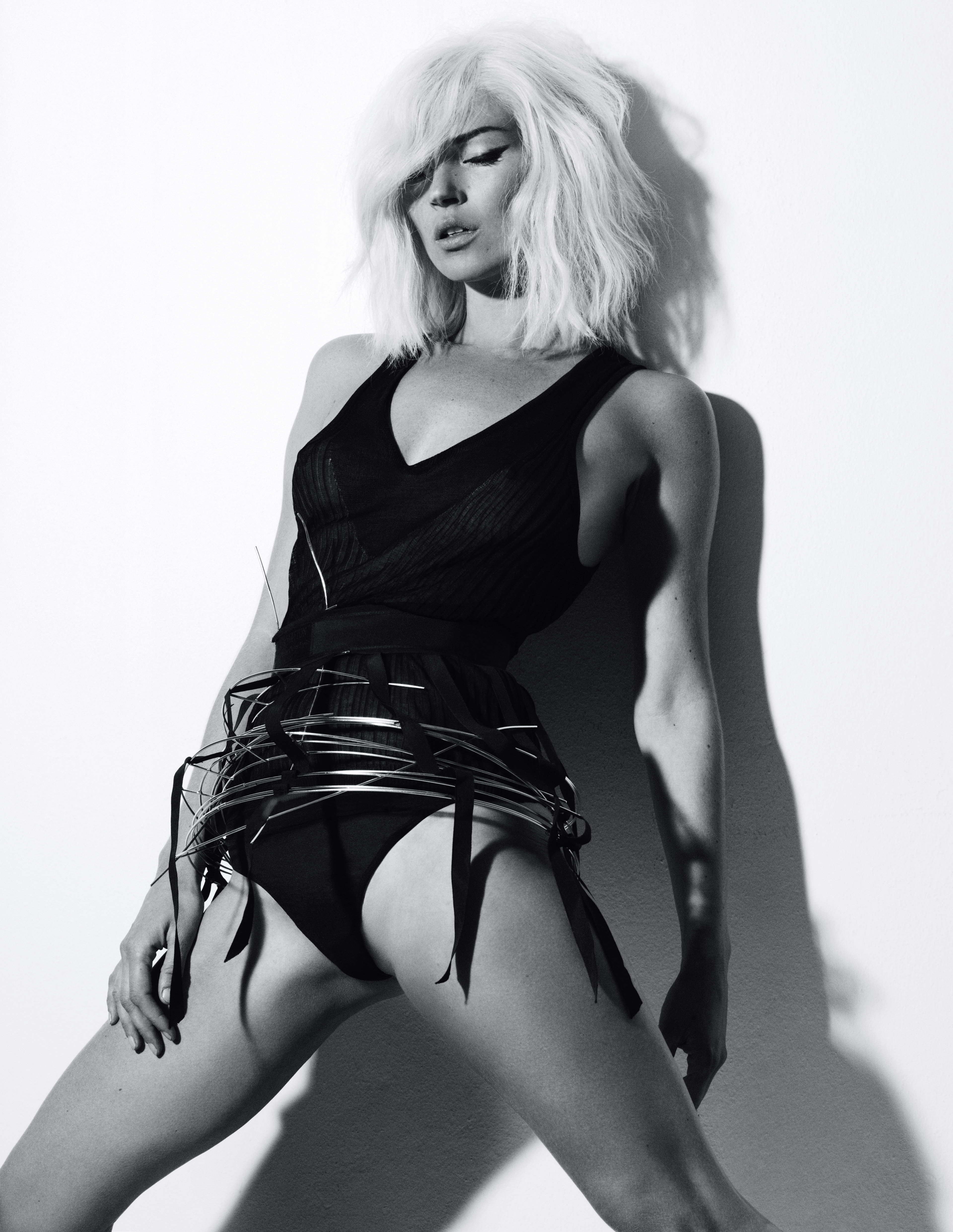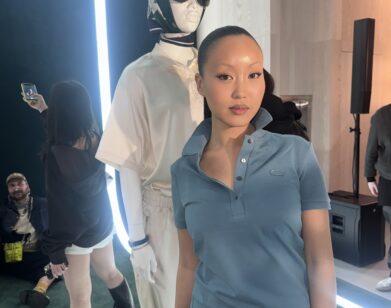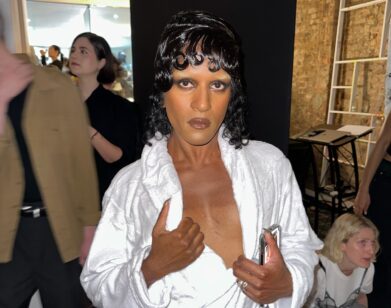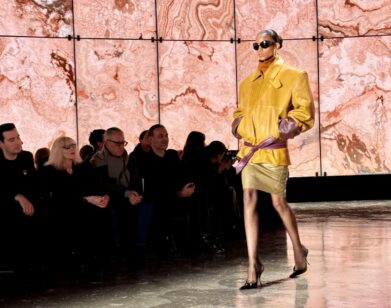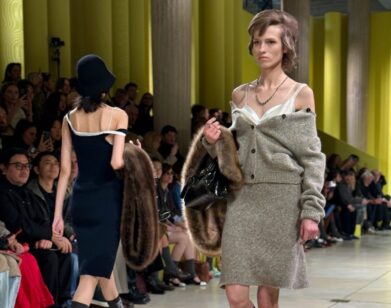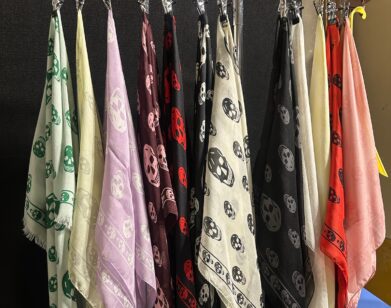Kate Moss: Enduring Style
In January 1993, Interview sat down with the late Corinne Day, ex-model-turned-photographer, who, most notably, put Kate Moss on the map when she selected Moss at a casting for The Face magazine. During the interview, conducted by Richard Pandsico, Corinne recalled being drawn to “her beauty, her personality… this potential in her, a diversity in her look.” Later, in a conversation with Kate’s mother, Corinne warned, “Kate is going to be a very famous model.”

And she was right. Since Kate’s initial discovery by Storm Model Management Founder, Sarah Doukas, in 1988 while sitting in coach on an airplane from New York’s JFK airport to her hometown in Croydon, England, Kate began a steady incline to stardom. Twenty-six years later, the seasoned model maintains her premiere position in fashion and pop culture as a household name and an international style sensation. Arguably the most celebrated and influential model of her time, it comes as no surprise that David Yurman, who initially signed her in collaboration with photographer Peter Lindbergh in 2004, has welcomed the supermodel back to his current advertising campaign—appropriately titled “Enduring Style.” Shot once again by Lindbergh, the images combine notes of past and present, to illustrate the brand’s timeless sophistication and ageless elegance—qualities fittingly shared by its longtime campaign model.
In celebration of David Yurman’s Fall 2014 campaign and 10 years in collaboration with Peter Lindbergh and Kate Moss, Interview revisited some of our favorite moments with the legendary supermodel.
May 1995—Kate isn’t quite yet a seasoned veteran, but she’s also no rookie model. She shot the Calvin Klein campaign with Mark Wahlberg nearly three years earlier in 1992, and has appeared in numerous shows in New York, London, and Milan Fashion Week. Nevertheless, she’s still shocked when, one month prior to this conversation, Gloria Gaynor surprised her for her 21st birthday party in L.A.
KATE MOSS: I was sitting on a sofa when you sang “Happy Birthday” to me. [gasps] I was like, “Oh my goodness, Gloria Gaynor.” It was so amazing. Everyone was like, “Man!” I was shocked. I didn’t know anything about it.
GLORIA GAYNOR: You didn’t? Oh, that must have been wonderful.
MOSS: Yes, thank you, thank you, and thank you!
GAYNOR: It was quite my pleasure.
MOSS: So, you’ve been working on a new record?
GAYNOR: It’s called I’ll Be There, and it has a duet with Isaac Hayes that is actually a Barry White cover called, “You’re the First, the Last, My Everything.”
MOSS: I love that song.
GAYNOR: Great. So what’s doing with you?
MOSS: I’ve got the shows coming up. I go to Milan on Thursday, and then Paris and New York. All the shows start—and the madness.
GAYNOR: I was in Paris recently for Fashion Week. All the designers were there, and they had shows for the entire week everywhere.
MOSS: The atmosphere changes the whole city. Fashion Week is everywhere! It’s crazy. And the parties…
March 1999—It’s Kate’s first cover for Interview, and she sits down with then-Interview Editor in Chief, Ingrid Sischy, for a candid conversation about her career trajectory and controversies over her weight and rumored substance abuse. Kate sets the record straight that she’s healthy and stronger than ever in her latest chapter.
SISCHY: What was it like for a schoolgirl from Croydon to suddenly find herself in Glamoursville? Kate, try to go back and remember how it felt, getting off that train, walking into that agency, and going on those first castings.
MOSS: I was really nervous. And intimidated by the whole thing-by all the people and all the buzzing, and all the sitting around waiting. I felt really small in this huge place. Now, after years of being in it, I know that it’s not that big at all. But it felt huge.
…
SISCHY: Looking back, it feels like that was all part of chapter one. Chapter two is when your career just exploded.
MOSS: There was a point when it all really took off and got quite overwhelming, even though I didn’t realize it. It looks like my career happened overnight, but it didn’t. I was basically living on my own from when I was 17 on.
SISCHY: And now you are…
MOSS: Twenty-five. And once it started to happen fast, I suddenly felt quite ill. I couldn’t get out of bed. I didn’t know what was wrong with me. And I went to the doctor and he said, “There is nothing wrong with you. Here’s some Valium.” And Francesca [Sorrenti] freaked out. She said, “No way! You can’t take that.” I wasn’t allowed to keep them myself. She’d give me like a fraction of a Valium.
SISCHY: Why do you think you had a freak-out?
MOSS: Because it felt so big. And all of a sudden to get all of this attention, and to be away from home and working all the time was hard. I was on planes all the time. And I didn’t see my friends. I cried a lot and was alone a lot. It was quite terrifying, actually.
…
SISCHY: Kate, it’s no secret that you took yourself away for a while, and that you’ve just gone back to work. One of the things that’s been striking is how glad people have been to see you again and to work with you again. Another thing that was striking was that you yourself decided to put a brake on it all in the first place, and check into a clinic. What happened?
MOSS: It was just a buildup, really. I was definitely living fast. It was, “Sleep? Why? Why not go on? There’s too much to do. There’re too many places to go.” I was working, I was traveling a lot. I was playing and I didn’t stop. It got to the point where it wasn’t so much fun anymore. It all became unbalanced, so one day I just said, “I can’t do this anymore. I’ve had enough.” It was getting ridiculous. I was not very happy. I was doing things that weren’t good for me. So I checked into the Churchill Priory clinic. It was the best thing I’ve done for ages. I needed to check in and ask, “What’s going on?” I had tried to stop certain things before; I had tried to get focused on other things. But I always ended up back in the same place, and it wasn’t making me happy. I needed to get the focus back, and ask, “What do I want?” Going on holiday wasn’t doing it. That’s not real life. I needed to do it in London. Then people found out, and the newspapers went at it and…
SISCHY: …the headlines.
MOSS: It doesn’t really matter. That wasn’t going to stop me from doing what I needed to do to get better. What people say isn’t going to stop me. I have to do things for myself.
SISCHY: So far, has it been different since you’ve returned to work?
MOSS: Yeah, it is different. It is quite amazing what I didn’t feel after a while. I didn’t really want to feel things, probably, but it’s been amazing what I have been feeling.
September 2008—Kate is back on the cover of Interview and has reigned supreme over the modeling industry for 20 years. She’s 34 and, with her own line of clothing at Topshop, a CFDA Fashion Award, and infinite mentions on best-dressed lists around the globe, she’s not slowing down. Glenn O’Brien, Interview‘s Editor in Chief at the time, spoke to Kate at the home of photographers Mert Alas and Marcus Piggott in Ibiza, about traveling around the world and her journey to the top.
GLENN O’BRIEN: You always know what to do, Kate. You must be this repository of wisdom. Like how to pack for a trip or how to avoid the person in the next seat in first class. Yeah, if you have to fly commercial, how do you handle that?
KATE MOSS: It’s all about the blanket. Blanket, pillow, and red wine. You should always be asleep on a plane.
O’BRIEN: You’re always traveling. You must be a genius at packing.
MOSS: No. It’s awful. I had this amazing P.A., and we used to pack together, and she got so used to what I wanted to pack that she got to the point where she would just do it all—and perfectly. Now she’s away having a baby, and I have completely forgotten how to do it. It’s so weird. I just organize by bags of specific things. Bags of knickers, bags of bikinis, bags of dresses. So it is contained and organized, but my suitcase is a mess if I do it myself.
…
O’BRIEN: Are you a scholar of modeling history?
MOSS: I’ve been doing it for 20 years, and I’ve worked with people who are obsessed with the history of fashion, so I’ve really seen a lot.
O’BRIEN: Have you been impressed by the work of other models?
MOSS: I think for me it’s those ’60s models, like Veruschka. I like a lot of those girls. You see those pictures of [Richard] Avedon’s and [Irving] Penn’s, and they’re just so iconic. But you can’t always tell if it’s the photographer or the model. When it’s great it’s probably both. I really work. I like feeling that I’ve nailed it, and we’ve got the picture.
O’BRIEN: So were you self-taught, or was it working with certain photographers that gave you a way to work?
MOSS: I would say I’m self-taught, but Corinne Day made me less conscious of myself. I was 15, and she’d make me take off my top, and I’d cry. After five years, you get used to it, and you’re not self-conscious anymore. You’re not conscious about your flaws. Bowlegs. Crooked teeth. That is what makes you different from everyone else. But when I was 15, I was like, “Oh no, I don’t want to be different. I want to have big tits! I want to look like Cindy Crawford!”
…
O’BRIEN: So what’s the secret of your longevity? You’ve never been out.
MOSS: Touch wood. I don’t know. You never know when it could end. But I think I have a good rapport with the people I work with and that really helps. If you like working with people and you always have a good time and you always do good work, then they’re going to book you again. I like doing what I do. It’s not, “Oh, God, not that again!” I get into it.
September 2013—It’s Kate’s most recent solo cover for Interview, as we have named her one of the most influential and celebrated models in the industry. She’s still working with many of the same brands and photographers as she was when we last saw her, re-iterating her commitment to her longstanding industry relationships, as told to Glenn O’Brien five years earlier. This time, Kate reflects on her love for London, and the young models of today.
INTERVIEW: You ended up making London your home. Which makes sense because you’re British. Did you always think that would be your home?
MOSS: Yeah, always. But I’ve lived other places. I lived in New York for seven years, although I was always in denial about it. Even though I had an apartment there, I always pretended I was just visiting. I do love New York. But I’m a Londoner at heart.
INTERVIEW: Does that mean you, like your fellow countrymen and women, were excited beyond belief about Prince William and the Duchess of Cambridge delivering a future king to England?
MOSS: I love the Royal Family. The Queen, she’s fabulous.
…
INTERVIEW: Do younger models come to you today for advice and protection?
MOSS: Sometimes they do, but I think it’s really difficult. It’s like with any young person—you can’t tell anybody what to do. They have to do it their way. You can’t say, “Oh please, I’ve been there, don’t do that.” Or it’s like when I hear someone say, “I was talking to my friend, and she’s 20 and…” And I think, “Oh god, I don’t want to hear about it. It’s too terrifying.” Because I’m a mother now. My daughter is only nine years away from being 20 herself. So I’m a bit more like that. I’m more protective. But you have to go through it yourself, don’t you?
INTERVIEW: Are you locking your daughter up when she turns 14?
MOSS: Yeah, absolutely.
INTERVIEW: If she wanted to be a model, would you forbid it?
MOSS: It’s up to her. At the moment, she’s definitely not into that. She’s not into having her picture taken. She gets shy.
INTERVIEW: Young models today are social-media stars. You don’t have a Twitter account. That game is not for you.
MOSS: It’s just a different generation, I think. That’s how they communicate. That’s what they do. All the kids do it. My daughter loves Instagram. I mean, I do Instagram but I’ve only got 25 followers.
INTERVIEW: I have a feeling if you told us your Instagram name, you’d get a few more followers when the issue comes out.
MOSS: Yes, but I don’t really want anyone to know where I am. I don’t want people to know what I’m doing. That’s the complete opposite of what I feel like.

